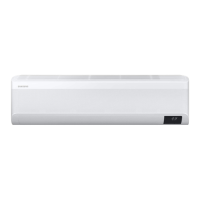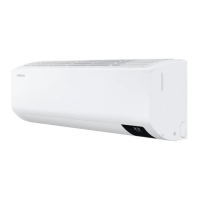Ignition sources free
• Make sure to store the units in a place without
continuously operating ignition sources (for
example, open flames, an operating gas appliance
or an operating electric heater).
• The service engineers shall not use any ignition
sources with the risk of fire or explosion.
• Potential ignition sources shall be kept away from
the work area where the flammable refrigerant can
possibly be released to the surrounding.
• The work area should be checked to ensure that
there are no flammable hazards or ignition risks.
The “No Smoking” sign shall be attached.
• Under no circumstances shall potential sources of
ignition be used while in detection of leakage.
• Make sure that the seals or sealing materials have
not degraded.
• Safe parts are the ones with which the worker can
work in a flammable atmosphere. Other parts may
result in ignition due to leakage.
• Replace components only with parts specified by
Samsung. Other parts may result in the ignition of
refrigerant in the atmosphere from a leak.
Area ventilation
• Make sure that the work area is well ventilated
before performing a hot work.
• Ventilation shall be made even during the work.
• The ventilation should safely disperse any
released gases and preferably expel them into the
atmosphere.
• Ventilation shall be made even during the work.
Leakage detection methods
• The leakage detector shall be calibrated in a
refrigerant-free area.
• Make sure that the detector is not a potential
source of ignition.
• The leakage detector shall be set to the LFL (lower
flammability limit).
• The use of detergents containing chlorine shall be
avoided for cleaning because the chlorine may react
with the refrigerant and corrode the pipings.
• If leakage is suspected, naked flames shall be
removed.
• If a leakage is found while in brazing, the entire
refrigerant shall be recovered from the product or
isolated (e.g. using shut-off valves). It shall not be
directly released to the environment. Oxygen free
nitrogen (OFN) shall be used for purging the system
before and during the brazing process.
• The work area shall be checked with an appropriate
refrigerant detector before and during work.
• Ensure that the leakage detector is appropriate for
use with flammable refrigerants.
Labelling
• The parts shall be labelled to ensure that they have
been decommissioned and emptied of refrigerant.
• The labels shall be dated.
• Make sure that the labels are affixed on the system
to notify it contains flammable refrigerant.
Recovery
• When removing refrigerant from the system for
servicing or decommissioning, it is recommended to
remove the entire refrigerant.
• When transferring refrigerant into cylinders, make
sure that only the refrigerant recovery cylinders
are used.
• All cylinders used for the recovered refrigerant shall
be labelled.
• Cylinders shall be equipped with pressure relief
valves and shut-off valves in a proper order.
• Empty recovery cylinders shall be evacuated and
cooled before recovery.
• The recovery system shall operate normally
according to the specified instructions and shall be
suitable for refrigerant recovery.
• In addition, the calibration scales shall operate
normally.
• Hoses shall be equipped with leak-free disconnect
couplings.
• Before starting the recovery, check for the status of
the recovery system and sealing state. Consult with
the manufacturer if suspected.
• The recovered refrigerant shall be returned to the
supplier in the correct recovery cylinders with the
Waste Transfer Note attached.
• Do not mix refrigerants in the recovery units or
cylinders.
• If compressors or compressor oils are to be
removed, make sure that they have been evacuated
to the acceptable level to ensure that flammable
refrigerant does not remain in the lubricant.
• The evacuation process shall be performed before
sending the compressor to the suppliers.
• Only the electrical heating to the compressor body
is allowed to accelerate the process.
• Oil shall be drained safely from the system.
• For installation with handling the refrigerant
(R-32), use dedicated tools and piping materials.
Because the pressure of the refrigerant, R-32 is
approximately 1.6 times higher than that of R-22,
failure to use the dedicated tools and piping
materials may cause rupture or injury. Furthermore,
it may cause serious accidents such as water
leakage, electric shock, or fire.
• Never install a motor-driven equipment to prevent
ignition.
41

